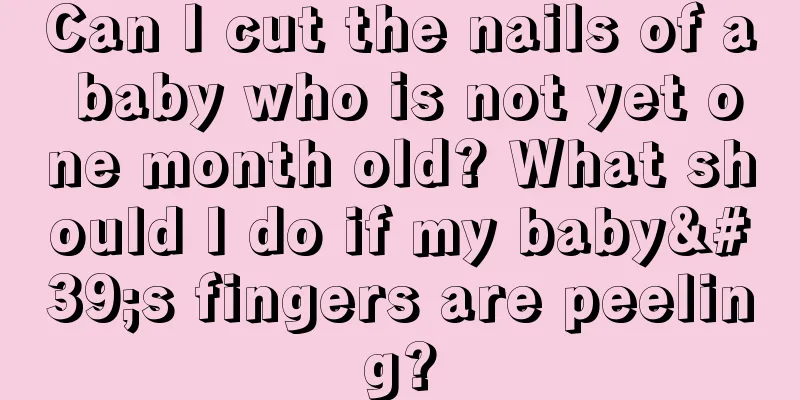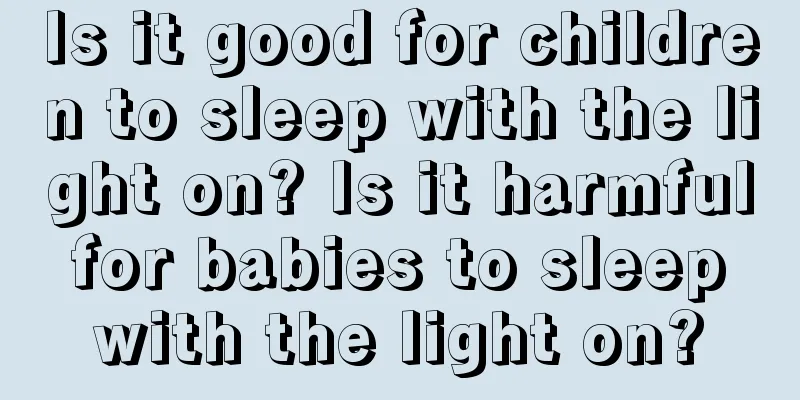Can I cut the nails of a baby who is not yet one month old? What should I do if my baby's fingers are peeling?

|
Nails that are too long are inconvenient for daily life and are not good for personal health. You should cut your nails frequently and keep them clean. If your baby's nails are too long, they may scratch their skin. So can you cut the nails of babies who are not even one month old? What should you do if your baby's fingers are peeling? Can I cut the nails of a baby who is not yet one month old?The nails of newborns are not fully formed yet, and they are very soft and will not hurt the baby. Therefore, it is not recommended to cut the nails of babies under 1 month old. When the baby grows up and scratches everywhere or the nails are too long and tear, then you need to cut the nails. After one month, the baby's nails have been fully formed. At this time, the baby is in a period of vigorous development, and his hands are very active. He often scratches his face unconsciously with his nails, leaving small scars everywhere. Some babies like to suck their fingers. Long nails can harbor dirt and grime, and sucking fingers can bring bacteria into the body. If the baby's toenails are too long, they often rub against pants and socks, which can easily cause splitting. Therefore, the fingernails and toenails of babies who are one month old should be trimmed regularly. What to do if your baby's fingers peel1. Dry peeling When the weather is relatively dry and the human body loses more water, or when the hand sanitizers, soaps, etc. that parents usually choose for their children are highly alkaline, there are also some possible vitamin deficiencies that cause dry skin and peeling. However, this kind of peeling is generally mild, with only mild peeling of the fingers or toes, without other rashes or itching. This kind of peeling generally does not require special treatment. Usually, pay attention to let your children drink more water, eat more fresh vegetables and fruits, and try not to choose hand sanitizers and shower gels that are more irritating for your children. 2. Ringworm If the peeling occurs on one hand first and then gradually spreads to both hands, and red spots can be seen on the palms, accompanied by obvious itching, in this case, it is necessary to consider whether it is tinea manuum. Patients with tinea manuum are contagious and can spread to other parts of the body, such as tinea pedis on the feet. Tinea manuum and pedis are generally caused by fungal infections. Once diagnosed, medication must be used promptly, standardized, and thoroughly under the guidance of a doctor. At the same time, special attention should be paid to daily necessities such as washbasins, towels, and handkerchiefs. Each person should have one item to avoid further infection to other parts or to other people. 3. Dyshidrosis Some children may experience dyshidrotic eczema due to excessive sweating on their hands. This is mainly a type of skin eczema, which is often manifested by the growth of small blisters on both hands at the same time, ranging in size from millet to rice, accompanied by varying degrees of burning and itching. The main way to prevent this dyshidrotic eczema is to keep children's hands clean and dry. In short, when children have peeling skin, it is recommended to follow the guidance of professional doctors and receive active treatment. At the same time, be careful not to tear the epidermis that has not fallen off naturally with your hands, so as not to cause bleeding and other symptoms that aggravate the peeling. Do not buy ointments and apply them yourself without authorization, so as not to aggravate the condition. Tips for cutting nails for babies of different ages0-1 years old: At this time, the baby is still too young to understand the meaning of nail trimming and may refuse or resist. It is recommended that mothers trim their nails when the baby is asleep. Because the baby's sensitivity to the outside world is greatly reduced during sleep, mothers can trim their nails without worry. 1-2 years old: At this time, the baby can understand what the mother says and understands the mother's intentions, but may still be a little reluctant to have his nails cut. It is a good time to cut the baby's nails after he falls asleep, but the baby's sleep time at this stage gradually decreases. The mother can also try to trim his nails when he is drinking milk or is relatively quiet. 2-3 years old: Babies at this stage can already understand adults' intentions. Mothers may wish to tell them the purpose of trimming their nails and ask them to cooperate. After trimming, they should be encouraged and praised. Be careful not to hurt the baby or make him feel scared. Of course, you should also pay attention to: try not to hurt the baby or forcefully trim his nails when he is in a bad mood, so as to avoid him feeling disgusted or resistant to trimming his nails. What causes urinary tract infection in babies?Urinary tract infection, also known as urinary tract infection, is caused by bacteria invading the urinary tract, which seriously endangers the health of children's urinary system. Urinary tract infection, also known as urinary tract infection, or "urinary infection" for short, is caused by bacteria invading the urinary tract. In fact, urinary tract infection is a common disease in children. The probability of children suffering from urinary tract infection is not low. According to the survey, this disease accounts for 8.5% of urinary system diseases in children, ranking fourth. This disease can occur in children of any age, and the incidence rate is particularly high in infants under 2 years old. The incidence rate of girls is 3-4 times that of boys, but only in infancy, boys are more likely to be infected than girls. This is mainly determined by the physiological and anatomical factors of infants and environmental factors. The urinary tract of infants and young children is prone to retrograde infection. Due to the frequent use of diapers or open-crotch pants, the urethral opening is often contaminated by feces and other unclean things. Escherichia coli, Proteus, Escherichia coli, Klebsiella, Streptococcus faecalis and Staphylococcus aureus and other pathogens accumulate around the urethral opening, looking for opportunities to take advantage of; infants, especially girls, have short urethras and poor sphincter function, so bacteria can easily go up along the urethra to the bladder; in addition, the terminal part of the ureter of infants and young children runs shorter in the bladder muscle layer, and the bladder cannot be compressed and closed when it expands. When the bladder is holding urine, it is easy to go up through the ureter and cause renal pelvic infection; plus infants and young children have imperfect immunity and poor defense ability, which is not only easy to cause ascending infection, but also may cause descending infection of the urethra due to upper respiratory tract infection, pneumonia, bacteremia, etc. Therefore, the younger the baby, the higher the incidence rate. Urinary tract symptoms are difficult to describe In fact, infants and young children with urinary tract infections also have symptoms of frequent urination, urgency, and pain when urinating, but they are unable to express them in words. In fact, crying, refusing to feed, and being irritable are manifestations of discomfort and pain in the urethra; Diapers need to be changed frequently, but the amount of urine each time is not much, which may be a manifestation of frequent urination and urgency; Diaper rash and smelly diapers are common in the perineum, which may be signs of urinary tract infection. These symptoms of urinary tract infection are easily overlooked. On the contrary, the most common external manifestation of infection is fever, which is often associated with easily observed respiratory or digestive tract symptoms, diverting the attention of parents and doctors and covering up the essence of urinary tract infection. Therefore, urinary tract infection in infants is often misdiagnosed. |
<<: Will stretch marks disappear? Is it possible to eliminate them on their own?
>>: How to bathe your baby correctly? What is the water temperature for bathing your baby?
Recommend
Can children eat eggs when their teeth are replaced? Can children have their teeth extracted when their teeth are replaced?
Children will start to replace their teeth when t...
Supplementing lutein helps children prevent myopia from getting worse - which brand of lutein is good for children
If a child develops myopia at a young age, it wil...
Can I have a baby during breastfeeding? Should I have an abortion during breastfeeding or medical abortion?
Pregnancy during breastfeeding is not a happy thi...
Which country's brand is Sensodyne toothpaste from? How to distinguish the authenticity of Sensodyne toothpaste?
The brand of toothpaste, Sensodyne, is also commo...
How long can the milk sucked out by the breast pump be kept? How to store the milk sucked out by the breast pump?
Nowadays, many mothers insist on breastfeeding, b...
What should pregnant women pay attention to when squatting on the toilet? What can pregnant women eat to relieve constipation immediately?
After becoming pregnant, pregnant women's exe...
A one-year-old girl accidentally got a screwdriver stuck in her brain while playing. How can we prevent children from getting hurt in our daily life?
Recently, it was reported that a one-year-old gir...
Nursing measures for acute mastitis How to treat acute mastitis
Many mothers suffer from mastitis due to improper...
What to eat during the confinement period in summer? What is the best food to eat during the confinement period in summer?
The weather is hot in summer, what should pregnan...
Which has a higher success rate, artificial insemination or IVF? The difference between artificial insemination and IVF
Artificial insemination and IVF are both advanced...
What is the reason for children's black teeth? What should I do if my child has black spots on his teeth?
Teeth are very important for children during thei...
How to make osmanthus wine? Can pregnant women eat osmanthus wine?
It is the season of sweet-scented osmanthus again...
How to deal with baby's earwax that becomes hard lumps? Here are 3 ways to deal with it
It is easy for earwax to grow in the ears, which ...
Signs that milk powder is not suitable for babies and signs that babies cannot absorb milk powder
It is a big problem for mothers to choose milk po...
Can I drink milk powder for pregnant women during breastfeeding? Is it good to drink milk powder for pregnant women during breastfeeding?
Whether it is during pregnancy or breastfeeding, ...









